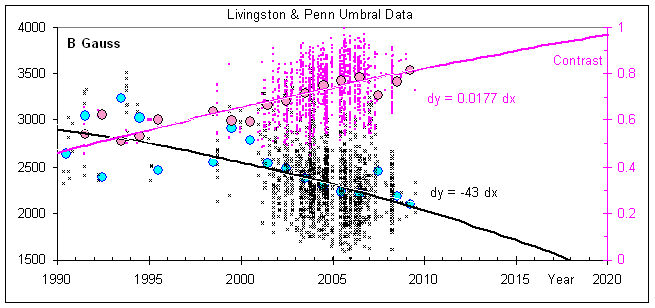Leif Svalgaard writes to inform me that Livingston and Penn have published their article recently in EOS, Transactions, American Geophysical Union.
As WattsUpWithThat readers may recall, we had a preview of that EOS article here.
Livingston & Penn write in the EOS article:
For hundreds of years, humans have observed that the Sun has displayed activity where the number of sunspots increases and then decreases at approximately 11- year intervals. Sunspots are dark regions on the solar disk with magnetic field strengths greater than 1500 gauss (see Figure 1), and the 11- year sunspot cycle is actually a 22- year cycle in the solar magnetic field, with sunspots showing the same hemispheric magnetic polarity on alternate 11- year cycles.
The last solar maximum occurred in 2001, and the magnetically active sunspots at that time produced powerful flares causing large geomagnetic disturbances and disrupting some space- based technology. But something is unusual about the current sunspot cycle. The current solar minimum has been unusually long, and with more than 670 days without sunspots through June 2009, the number of spotless days has not been equaled since 1933 (see here).
The solar wind is reported to be in a uniquely low energy state since space measurements began nearly 40 years ago [Fisk and Zhao, 2009].
The full article as a PDF is available here
Leif also provides his version of their Figure 3 (showing umbral intensity -vs- total magnetic field which I'm sure he'll want to discuss here.





Reader Comments
to our Newsletter